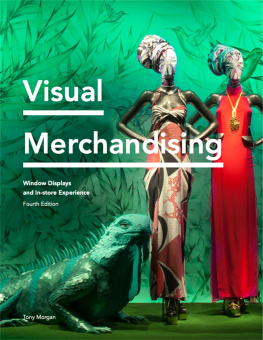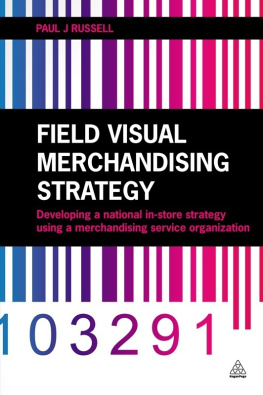Contents
Guide
Visual
Merchandising

Published in Great Britain in 2021 by
Laurence King Student & Professional
An imprint of Quercus Editions Ltd
Carmelite House
50 Victoria Embankment
London EC4Y 0DZ
An Hachette UK company
Copyright text 2008, 2011, 2016, 2021
Tony Morgan
The moral right of Tony Morgan to be identified as the Author of this work has been asserted with the Copyright, Designs and Patents Act 1988.
All rights reserved. No part of this publication may be reproduced or transmitted in any form or by any means, electronic or mechanical, including photocopy, recording or any information storage and retrieval system, without prior permission in writing from the publisher.
A CIP catalogue record for this book is available from the British Library
ISBN 978 1 52942 318 1
Quercus Editions Ltd hereby exclude all liability to the extent permitted by law for any errors or omissions in this book and for any loss, damage or expense (whether direct or indirect) suffered by a third party relying on any information contained in this book.
Design concept by TwoSheds
Picture research: Peter Kent
Cover image: courtesy Printemps Francis Peyrat

Papers used by Quercus are from well-managed forest and other responsible sources.
Visual
Merchandising
Window Displays and In-store Experience
Fourth Edition
Tony Morgan
Laurence King Publishing
An imprint of Quercus Editions Ltd
www.laurenceking.com/student/

Contents

A metallic window scheme entitled Mirror Mirror attracts customers with its reflective qualities at Selfridges, London.
Preface
Nobody can dispute the fact that the retail landscape has changed dramatically over the last few decades. While consumers and businesses see the ever-emerging new technology of the digital age as a disrupter, successful brands also view it as an enhancer that will undoubtedly drive sales, whether online or in-store.
The challenge for traditional bricks-and-mortar retailers is to ensure that, however consumer behaviour might change, people continue to visit retail spaces. This is where skilful visual merchandising is essential.
If you have ever stood outside a shop admiring the artistry of the window display, been distracted by a sale item while passing through a department store, or paused to take in information from a store guide, then you have been sidetracked by visual merchandising. If you purchased something as a result of stopping in your progress along the street or through a store, then you have succumbed to its supremacy.
For years, the creative individuals who made the stores of the world look appealing for retailers and their loyal customers were known as window dressers or display artists. Display teams had a unique and much-envied function in a store. Occasionally with generous budgets and most definitely with a huge amount of talent they locked themselves away in studios or lurked behind the curtains of the windows and produced stunning, eye-catching works of art for the shopping community to admire from the street. During the 1980s, possibly because of a global recession and the threat of e-commerce, store bosses suddenly questioned the number and abilities of these non-profit-making departments. As a result, they began to push the display artists in-store to cast a creative eye over the racks and rails of discounted merchandise. Thus the visual merchandiser was born. Rarely taken seriously at first because their new roles were unexplained, visual merchandisers were soon laying out departments complete with sight lines, focal points and hot shops. A new retail vocabulary came into existence, and soon store interiors had as much sparkle as their windows.
Today visual merchandisers command respect, and are a sought-after commodity in the retail world because they provide not only a service, but also inspiration and commerciality. In addition, more than ever, they must be able to adapt to change and react quickly to trends, both fashion and social. Todays customer expects an experience that they can share on social media. This is created by talented visual merchandisers who rely on trusted techniques and practices while looking to the future for new developments that will enhance their work.
This book aims to enlighten and educate students and retailers about the workings of the world of the visual merchandiser. It covers the art of both the window display and in-store visual merchandising, and looks at the tools traditional and high-tech that will help any visual merchandiser succeed. By using case studies and specially commissioned illustrative diagrams, together with images of the best window displays and store interiors from around the world, this book will show the reader how effective visual merchandising can improve a stores brand image and inspire customers to spend.
1. The history of visual merchandising

In these attention-seeking, award-winning windows designed by Thomas Heatherwick for Harvey Nichols in London, the scheme explodes through the glass on to the exterior of the store.
The Development of the Department Store
The first shopkeepers tried to lure consumers into their stores by ostentatiously exhibiting their names or by displaying products in their windows or on tables in the street, proving that they were open for business and proud of their produce.
To this day, many florists not only pack their windows with the finest blooms, but also trail them outside the store and on to the pavement to entice customers across the threshold using colour and scent. Similarly, barbers sometimes push a chair containing an unsuspecting client up to the window in order to prove their skill and popularity.
With the advent in the 1840s of new technology that allowed the production of large panes of glass, department stores were responsible for taking the art of window display to a higher level, using their large windows as stages, some of them as theatrical as a Broadway show. Today colour, props and atmospheric lighting on many occasions arrogantly overshadow the merchandise, as visual merchandising extends beyond its role of supporting the wares and becomes an art form, creating a statement and provoking a reaction. Stores such as Londons Harvey Nichols have collaborated with well-known designers and artists to produce eye-catching schemes that make the merchandise part of an artistic work.
Harrods opened in London in 1849 as a small shop selling groceries, perfume and stationery, and grew to become the renowned department store it is today. Mitsukoshi, Tokyos leading department store, was established even earlier, in 1673, as a kimono specialist. Its innovation was the concept of bringing the customer to a store rather than selling from door to door.
















